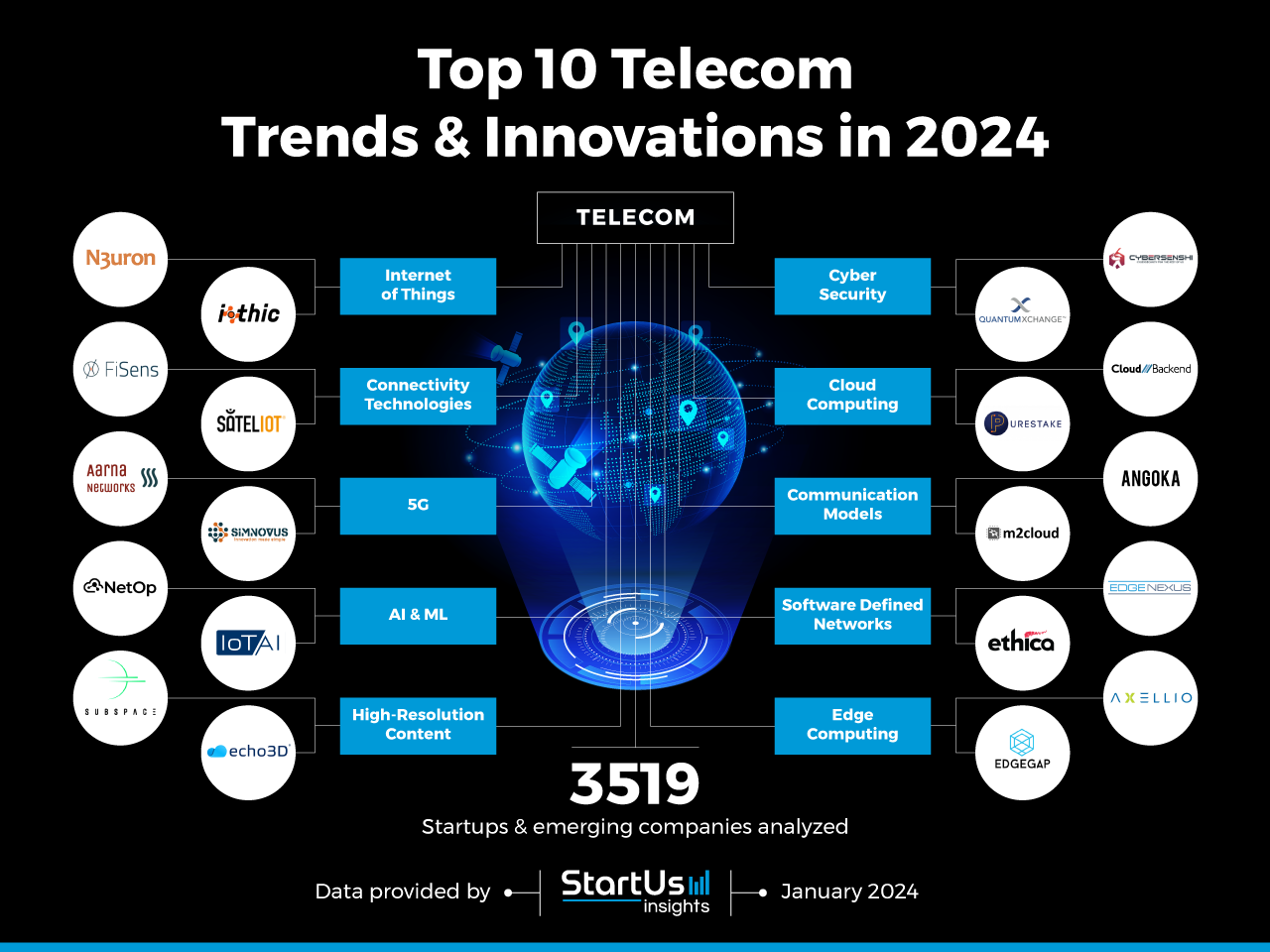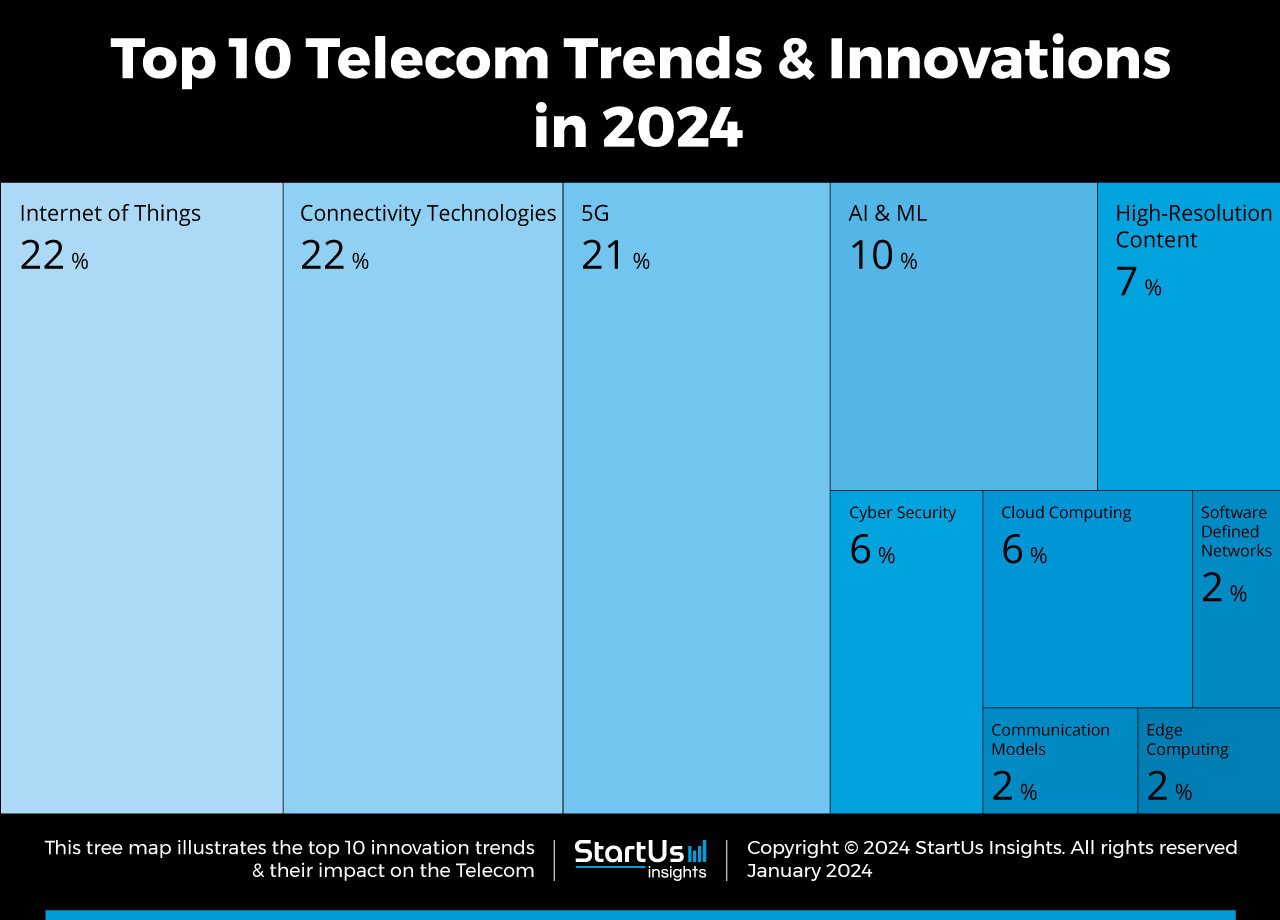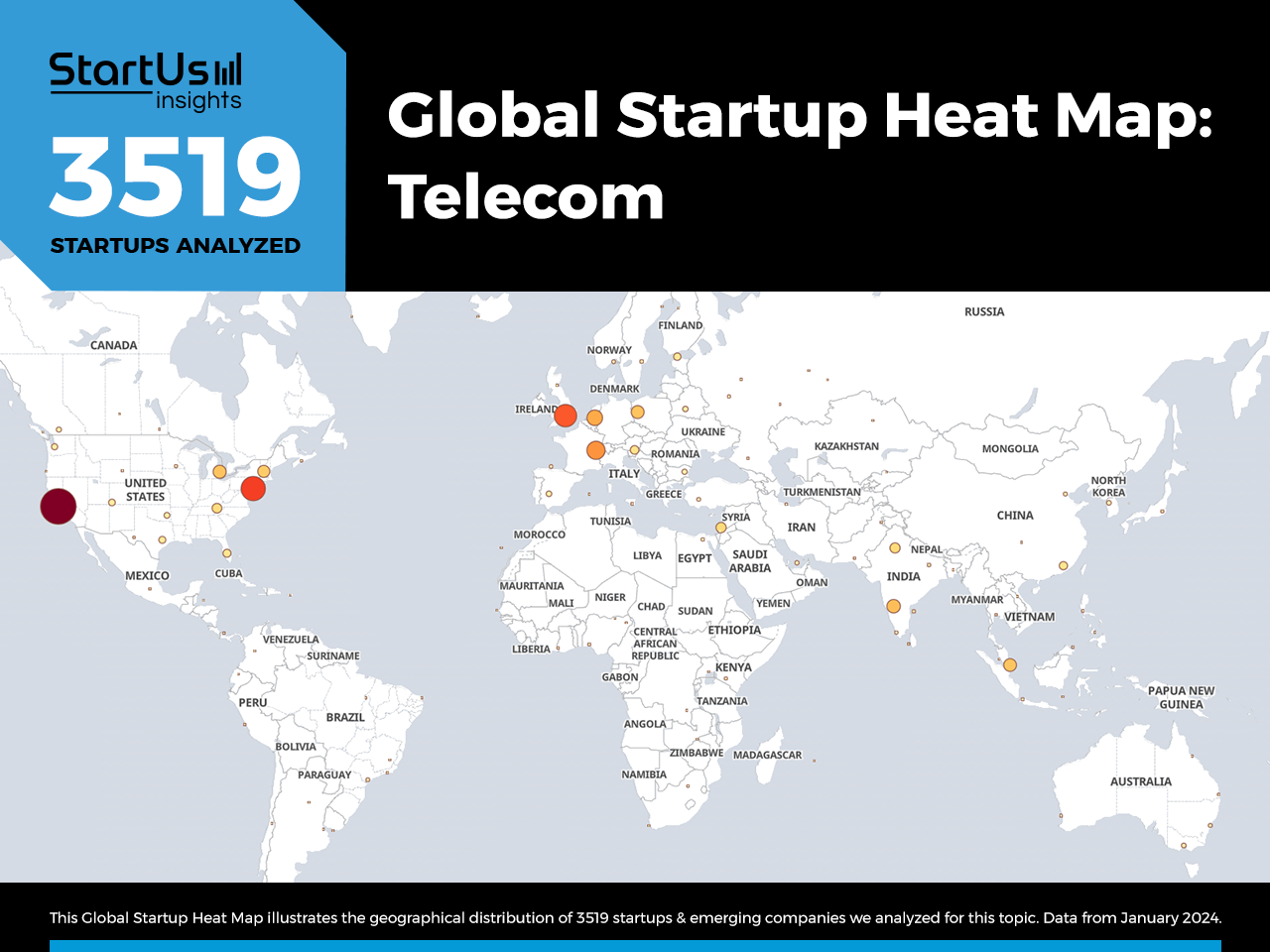Accelerate Productivity in 2025
Reignite Growth Despite the Global Slowdown
The telecom industry faces challenges like managing network demands, optimizing infrastructure, resolving customer issues, and strengthening security. Top trends in the industry are helping telecom companies address these issues and improve efficiency. With the growing global connectivity accelerated by the COVID-19 pandemic, telecom companies have opportunities to expand their customer base and introduce innovative products and services.
Key trends include the need for reliable and cost-effective solutions in cloud computing and 5G technology, especially in smart ecosystems like factories, cities, homes, vehicles, and industrial workplaces, where more connected devices and people require advanced connectivity solutions.
This article was published in February 2021 and updated in January 2024.
Innovation Map outlines the Top 10 Telecom Industry Trends & 20 Promising Telecom Technology Companies
For this in-depth research on the Top Telecommunications Industry Trends & Startups, we analyzed a sample of 3519 global startups & scaleups. This data-driven research provides innovation intelligence that helps you improve strategic decision-making by giving you an overview of emerging technologies in the telecom industry. In the Telecom Innovation Map, you get a comprehensive overview of the innovation trends & startups that impact your company.
Top 10 Latest Trends in the Telecom Industry (2024)
- Internet of Things
- Connectivity Solutions
- 5G & Network Infrastructure
- Artificial Intelligence
- High-Resolution Content
- Cybersecurity
- Cloud Computing
- Communication Models
- Software Defined Networks
- Edge Computing
These insights are derived by working with our Big Data & Artificial Intelligence-powered StartUs Insights Discovery Platform, covering 3 790 000+ startups & scaleups globally. As the world’s largest resource for data on emerging companies, the SaaS platform enables you to identify relevant technologies and industry trends quickly & exhaustively.
Tree Map reveals the Impact of the Top 10 Trends in Telecommunication (2024)
Based on the Telecom Innovation Map, the Tree Map below illustrates the impact of the Top 10 Telecom Industry Trends in 2024. The Internet of Things (IoT) devices and sensors, connectivity solutions including next-generation WiFi and Bluetooth, as well the promise of 5G networks and technology dominate the top 10 telecom trends. Artificial intelligence (AI) influences data analytics and offers various opportunities for automation in the telecom sector.
The penetration of smartphones and reliable internet further generates large volumes of high-resolution content. In addition to these emerging trends in the telecom industry, the industry also sees the development of cloud and edge technologies for enabling smart industrial processes as well as solutions to improve human-to-machine and machine-to-machine communications. Get in touch with us to find relevant startups that impact your specific business.
Global Startup Heat Map covers 3500+ Telecom Startups & Scaleups
The Global Startup Heat Map below highlights the global distribution of the 3519 exemplary startups & scaleups that we analyzed for this research. Created through the StartUs Insights Discovery Platform, the Heat Map reveals that the US is home to most of these companies while we also observe increased activity in Europe as well as Asia, particularly in India & Singapore.
Below, you get to meet 20 out of these 3519 promising startups & scaleups as well as the solutions they develop. These 20 startups were hand-picked based on criteria such as founding year, location, funding raised, and more. Depending on your specific needs, your top picks might look entirely different.
Interested to explore all 3500+ telecom startups & scaleups?
10 Key Trends in Telecom Industry (2024)
1. Internet of Things
IoT devices and sensors are significantly impacting various sectors of the technology economy, enhancing people’s quality of life, boosting businesses’ profitability, and improving overall management. Additionally, IoT offers cost-saving benefits for governments seeking to reduce their IT-related expenses. The interconnected nature of devices, sensors, infrastructure, and computing components is opening up innovative avenues for management.
For instance, through functionalities like decentralized operations, condition-based monitoring, and predictive maintenance, IoT facilitates seamless communication among diverse IoT devices. This level of automation streamlines production processes and allows the implementation of Industry 4.0 concepts in the telecom sector.
N3uron builds a Web-based SCADA Software
Spanish company N3uron develops highly customizable Industrial IoT and supervisory control and data acquisition (SCADA) software solutions to empower organizations to efficiently collect data. One of the N3uron’s multiple integrated software modules, MQTT, uses special data-transfer protocols to connect thousands of field devices to any cloud or SCADA system.
N3uron software runs on multiple operating systems and hardware without affecting performance. Moreover, the software’s built-in networking security and data integrity checks follow industry standards of data formats. All of this allows companies to efficiently create and operate IIoT device networks.
Iothic develops a Decentralised IoT Standard
British startup Iothic creates a communication protocol for the Internet of Things. The main benefit of the startup’s solution is interoperability. The communication protocol enables companies to work on different devices and operating systems that are compatible with existing infrastructure.
Further, a high level of security, with support for real-time low-latency operations, suits next-gen IoT applications, together with resistance to quantum decoding. The IoT standard helps manufacturers and customers by helping them reduce production and operational expenses.
2. Connectivity Technologies
Connectivity technologies are in a continuous state of evolution, encompassing both wired and wireless communication methods. In the contemporary IT landscape, the advancement of communication technology holds paramount importance, given the rising data volumes, proliferation of IoT devices, and growing internet user base.
Furthermore, users are increasingly engaged in sharing high-quality digital content like videos, photos, and music. All these factors, along with the expanding utilization of satellite communications, play a pivotal role in shaping the prominent trends within the telecom industry, driving innovation in connectivity technologies.
FiSens manufactures Fiber Optic Sensor Systems
German startup FiSens manufactures Fiber Bragg Gratings (FBG) sensors for measuring strain, temperature, and pressure. The startup leverages the FBG effect, which allows the creation of chains without breaking fiber optics for data transmission.
FiSens embeds sensors in the fiber optics, allowing up to 30 sensors in a single fiber. The startup produces FBGs for almost all possible spectral configurations. Additionally, these sensors are immune to electromagnetic interference and are safe in environments that involve radiation or explosions.
Sateliot connects IoT Devices using Satellites
Sateliot is a Spanish satellite telecom operator for global continuous IoT connectivity, merging satellite and terrestrial networks under 5G protocols. Their hardware does not require any customization on the device side since satellite constellations act as cell towers for IoT devices.
Moreover, satellites handle messages in a secure and transparent way, ensuring customers’ data is safe. Sateliot’s connectivity solutions find applications in a wide range of industries, including utilities, maritime, oil & gas, and agriculture.
3. 5G Network & Technology
5G technology represents the upcoming major advancement in telecommunication networks and devices. It offers significantly higher speeds compared to previous cellular broadband standards and, crucially, boasts remarkably lower latency. Low latency is especially critical for applications like cloud gaming and VR content streaming.
Within the telecom industry, 5G introduces the capability for massive machine-type communications (mMTC), facilitating the establishment of dense IoT networks, spanning from Industrial IoT (IIoT) to smart homes. The broad array of applications stemming from this development positions 5G as one of the most prominent trends in the telecommunications sector.
The market for 5G technology is expected to see substantial growth, with operators projected to generate USD 400 billion in service revenue from 5G networks in 2024. This represents an annual growth rate of 32% from 2023, highlighting 5G’s significant impact on the telecommunications sector
Aarna Networks creates a Multi-Cluster Orchestration Platform
US-based 5G telecom company Aarna Networks provides a multi-cluster orchestration platform – AMCOP. AMCOP automatically manages cloud infrastructure and connected networks, such as Edge networks. AMCOP supports 5G radio access networks (RAN), and 5G Core (5GC) orchestration, as well as network slicing, data analytics, and self-organizing networks (SON). Also, AMCOP is built on vendor-agnostic open-source software, helping businesses optimize their expenditures on network infrastructure and increase security.
Simnovus provides a Cost-Effective User Equipment (UE) Simulator
Simnovus is an Indian startup, building efficient UE simulators for 5G networks. Based on software-defined radio (SDR) technology, the startup allows transforming traditional x86 hardware into a UE simulator. This agile and cost-effective solution is suitable for testing telecommunication equipment and developers of such equipment.
The UE simulator provides testing with realistic patterns of traffic for different network technologies, extensive logging, and elaborate statistics. Further, the simulator’s licensing supports up to 1000 devices.
4. Artificial Intelligence
Artificial intelligence (AI) and machine learning (ML) stand out as significant trends in the telecom industry, exerting a profound impact. The process of digital transformation necessitates the extraction of valuable insights from the vast data generated by IoT sensors and devices.
Simultaneously, the expansion and increasing complexity of the internet have raised the demand for high-speed connections with minimal latency. In response to these challenges, startups are developing AI-driven solutions that effectively address various issues related to network performance and management.
Netop develops Autonomous solutions for Critical Networks
NetOp is a startup from Israel, creating a critical network health utility tool using proprietary machine learning algorithms. The solution automatically analyzes the network, searching for any vulnerabilities. Using AI-powered advanced automation, NetOp proactively predicts and remediates network issues as they arise. These are beneficial for businesses wanting to improve their security and reduce operating costs.
IoT/AI creates an Advanced Sensor Platform
The US-based startup IoT/AI offers an IoT platform that combines network connectivity, cybersecurity, and analytics operating in Edge networks. The platform analyzes the data from the mesh network locally using ML algorithms. In addition to military-grade cybersecurity, IoT/AI’s sensor platform is suitable for the industrial, healthcare, defense, and energy industries.
5. High-Resolution Content
The widespread use of smartphones and the availability of reliable internet connections have resulted in increased consumption of high-quality content, often characterized by large file sizes. This surge in high-resolution content has, in turn, driven enhancements in the quality of traditional media like videos, images, and music.
In response to this evolving landscape, innovative telecommunications technologies are assisting businesses in adapting to emerging forms of media, such as virtual, augmented, and mixed reality (VR/AR/MR) experiences, as well as cloud-based gaming. These new content formats demand not only high-speed data transmission but also low latency, prompting startups to focus on developing robust and high-capacity telecommunication networks.
Subspace builds Networks for Online Gamers
Subspace is a US-based startup building networks specifically for online multiplayer games. To reduce lag and create a seamless experience for gamers, the startup uses a combination of hardware and software solutions. These include custom network routing hardware built for accelerating games and software to protect the integrity of the game. Together, these measures lead to higher player retention, matchmaking pools, and revenue for studios as well as publishers.
Echo3D creates Tools for Building & Scaling 3D Apps
US-based startup Echo3D creates tools to facilitate 3D application development, improve its deployment, and manage related procedures. The tools focus on cross-platform AR/VR program development. While most AR/VR applications today support single-user, single-device static experiences, the startup’s flexible cloud infrastructure makes content management & delivery simple. By making possible AR/VR products, deployable everywhere, the solution benefits brands and enterprises seeking to improve their consumers’ experiences.

6. Telecom Cybersecurity
The rising frequency of cyberattacks, coupled with the proliferation of low-security IoT devices and the emergence of new CPU hardware vulnerabilities, presents a formidable challenge in addressing security risks. As our reliance on computing infrastructure continues to grow, safeguarding against these threats becomes increasingly complex.
In industrial networks, there is a constant effort to manage systems to stay ahead of evolving cyber threats. However, these security measures can sometimes clash with the fundamental requirements of network reliability and availability. Startups are at the forefront of innovation in industrial networks, introducing dynamic solutions that enable systems to adapt in the face of attacks or vulnerabilities.
Cybersenshi rectifies Network Weaknesses
Cybersenshi is a startup from Saudi Arabia developing a cybersecurity tool that discovers and fixes customers’ websites & network security weaknesses. The database covers over 130.000 cybersecurity weaknesses of websites, networks, systems & databases. It is suitable for both small businesses, without deep knowledge of cybersecurity as well as for medium and big businesses.
Quantum Xchange creates Quantum-Safe Cybersecurity solutions
US-based startup Quantum Xchange develops Phio TX and Phio Quantum Key (QK). Phio TX works on current network infrastructure, improving communications security and making existing key infrastructure quantum-safe. For a higher security level, quantum keys are used in combination with Phio TX over any type of data transmission. Further, Phio TX requires low infrastructure, which is beneficial for companies looking to bolster security.
7. Cloud Computing
Cloud computing is a rapidly growing trend in the telecom industry, primarily driven by the widespread use of IoT devices and the deployment of advanced ML algorithms, both of which generate a substantial demand for computing power. The migration of data, applications, and essential business components to cloud computing environments offers numerous advantages.
In this landscape, cloud startups play a crucial role by providing enhanced connectivity and integration solutions across equipment, platforms, infrastructure, and various company functions. From equipment, platforms, infrastructure, and company functions, cloud startups offer greater connectivity and integration solutions for businesses. These startups are instrumental in advancing cloud integration technologies, ensuring seamless connections across a wide array of environments, from cities and factories to homes and vehicles.
Cloud Backend provides a Cloud Management Platform
Swedish startup Cloud Backend provides a platform for subscription, data policies, and resource budget allocation using a web-based dashboard. The dashboard’s architecture scales to multiple edge nodes, providing automatic synchronization and caching to secure network operations in case of failure. Cloud Backend’s architecture is also suitable for enterprises expanding or optimizing their networks and systems.
Purestake develops Cloud-Based Tools for Blockchain Networks
Purestake is a US-based startup developing an Infrastructure-as-a-Service (IaaS) platform that delivers consistent uptime and availability. The startup combines the best practices in network architecture and security operations.
The platform disperses nodes globally and, based on an automated multi-pop and multi-cloud approach, the service spans Amazon Web Services (AWS), Microsoft Azure, and Google environments. Further, the security of blockchain networks allows companies to build resilient, auto-managed networks for their needs.
8. Communication Models
The proliferation of smart and IoT devices is giving rise to a multitude of communication channels, including machine-to-machine (M2M), vehicle-to-everything (V2X), device-to-device (D2D), and human-to-machine interactions. These communication models vary in their use of connectivity technologies, encompassing both hardware and software components.
These communication models are being integrated to incorporate next-generation WiFi and Bluetooth technologies, forming the foundation for innovative products and technologies across a diverse spectrum of companies. These companies range from major banks and automobile manufacturers to technology startups and scaleups.
M2Cloud builds Device Cloud solutions
Indian startup M2Cloud creates device-to-cloud (D2C) solutions. They produce both simple and advanced vehicle tracking devices, aimed at creating an intelligent transport system to optimize existing public transport infrastructure. Additionally, M2Cloud produces wall-mounted sensors, both ultrasonic and infrared, for measuring body temperature.
It is especially useful for establishments to check their customers and workers during the COVID-19 pandemic. M2Cloud tracking devices also use eSIMs to easily connect to the cloud.
Angoka provides Hardware for Machine-to-Machine (M2M) Security
Angoka is a UK-based startup providing hardware solutions for managing cybersecurity risks inherent in M2M communication networks. The startup aims to improve security for connected and autonomous vehicles, smart city services, electrical grids, and banking networks.
The solution provides hardware authentication using a decentralized cryptographic protocol. Angoka’s solution also enables silicon devices’ fingerprinting based on their physical properties, which then allows for generating cryptographic keys and secure device identity.
9. Software-Defined Networks (SDNs)
In today’s increasingly digital environment, business applications require high-performing and extensive networking operations. This is particularly crucial in the context of cloud computing, where businesses must efficiently deploy, manage, and support connectivity across various environments. Typically, complex tools are needed to build and oversee modern software-defined networking technology.
Some vendors restrict their solutions to their own equipment, which limits the range of communication capabilities. However, startups are driving the development of SDN to improve network performance, monitor its efficiency, and enable centralized control.
EdgeNEXUS develops Load Balancing solutions for SDNs
UK-based startup EdgeNEXUS develops network load-balancing solutions for SDNs. edgeNEXUS optimizes routing changes based on a number of factors including load volume and application performance, thus adding a layer of intelligence between applications, networks, and SDN controllers.
The startup’s Global Server Load Balancer (GSLB) provides tools for multi-datacenter, multi-cloud, and hybrid cloud load balancing and failover. GLSB is suitable for enterprises looking to control their application delivery service depending on the user or region.
Ethica provides SD-WAN for Small & Medium Enterprises (SMEs)
Ethica is a Canadian startup providing CloudAccess, an easy-to-deploy and inexpensive Software-Defined Wide Area Network (SDWAN) solution focusing on SMEs. The solution reduces the downtime of the network by aggregating multiple internet connections and using them when they are available.
Also, CloudAccess provides Quality of Service (QoS) by prioritizing more important types of traffic which is useful, for example, in distributed teams using video calls. Further, all the solution’s features are manageable through a cloud-hosted orchestration utility.
10. Edge Computing
Edge computing in the telecom sector involves moving data computation and storage closer to the data source, as opposed to relying on a centralized remote cloud. This approach reduces latency, enhances bandwidth, streamlines maintenance, and enables companies to expand their computing capacity more affordably by integrating devices with edge data centers.
The demand for lower latencies and high-speed connections is paramount in today’s applications, such as cloud gaming and VR. Edge computing significantly enhances the end-user experience quality and reduces data exchange demands.
Edgegap enables Edge Network Game Hosting
Belgian startup Edgegap provides Edge network-based game hosting services. By locating online game-hosting servers in close proximity to the actual players, the startup ensures low latencies. Edgegap currently has 220 hosting locations available. Moreover, the services are easily scalable and reliable. Edgegap provides equal latencies for all players connected to a single game, ensuring fairness, which is very important in competitive gaming.
Axellio builds an Edge-Computing Hardware Platform
US-based startup Axellio builds FabricXpress – a high-performance, high-density computing, and storage platform for heavy applications. This solution is suitable for Edge networks that have a high density, high bandwidth, and low latency requirement. In addition to improving network performance, the startup achieves this with a small energy footprint and low costs.
Discover all Technologies, Startups, & Latest Trends in Telecom Industry
The insights on new telecom trends and startup developments provided in this report offer a preliminary glimpse into the wealth of findings derived from our exhaustive research efforts. Notably, within this expansive landscape, transformative elements such as AI, 5G, and pioneering connectivity innovations are poised to redefine the industry’s current paradigm.
Recognizing these emergent opportunities and cutting-edge technologies for early integration into your business strategy confers a substantial competitive advantage. Get in touch to easily and exhaustively scout relevant technologies & startups that matter to you.


 WATCH THE VIDEO VERSION
WATCH THE VIDEO VERSION 


![10 Top AI Solutions for Telecom Operations [2025]](https://www.startus-insights.com/wp-content/uploads/2025/06/AI-Solutions-for-Telecom-Operations-SharedImg-StartUs-Insights-noresize-420x236.webp)





